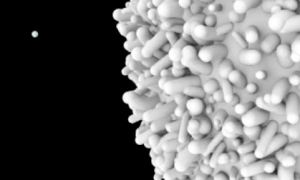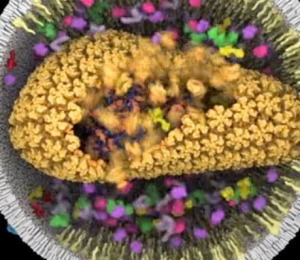New online animation of HIV lifecycle
21 May 2018. Related: Basic science and immunology, On the web.
Simon Collins, HIV i-Base

Iwasa J. The HIV lifecycle.
A new six-minute, easy to watch, animation of the HIV lifecycle is now online, produced by Janet Iwasa from the University of Utah. [1]
Together with a narrative, the film presents details that are not usually included in simplified summaries.
For example:
-

Iwasa J. The HIV lifecycle.
After entry into the cell, the capsid travels towards the nucleus using a network of micro tubules.
- Reverse transcriptase is shown as largely being active within the capsid, rather than in the cytoplasm. Whether the capsid dissolves before or at the time of integration into the nucleus was a controversial topic at CROI 2017, with work in the UK by Greg Towers and colleagues suggesting that uncoating is a late event and the nucleotides to enable reverse transcription are imported into the capsid through pores. [2, 3]
- That multiple RTs work simultaneously to create the double-strand DNA copy of the HIV RNA genome.
- Multiple outcomes for new viral RNA after leaving the nucleus.
- Details of the budding of new virions from the cells using a lattice of multiple gag proteins and recruitment of numerous other proteins, including final ESCRT-III proteins.
- That protease is only apparently active in chopping and reassembling new viral particles after the virion has budded from the cell.
-

Iwasa J. The HIV lifecycle.
Similarly, the new capsid is also shown as only forming after budding of the new virions, as a final process of becoming newly mature virus, ready to repeat the cycle with new CD4 host cells.
This animation was first previewed at CROI 2018 as part of the young investigator pre-meeting. which includes a useful discussion. [4]
Further animations are planned to show the impact of different classes of ART.
The same website includes a simpler animations on HIV cure research.
References
- Iwasa J. The HIV lifecycle. Online animation.
http://scienceofhiv.org/wp/?page_id=20 - Jacques DA et al. HIV-1 uses dynamic capsid pores to import nucleotides and fuel encapsidated DNA synthesis. Nature volume
536, pages
349–353 (18 August 2016). doi:10.1038/nature19098.
http://www.nature.com/articles/nature19098 - Mamed JI et al. Early cytoplasmic uncoating is necessary for infectivity of HIV-1.CROI 2017, 13–16 February 2017, Seattle. Oral abstract 15.
http://www.croiconference.org/sessions/early-cytoplasmic-uncoating-necessary-infectivity-hiv-1 (abstract)
http://www.croiwebcasts.org/console/player/33354 (webcast) - Iwasa J. Seeing HIV: animating the HIV lifecycle. Program committee workshop for new investigators and trainees. CROI 2018 Abstract 14.
http://www.croiwebcasts.org/console/player/37002 (webcast)

